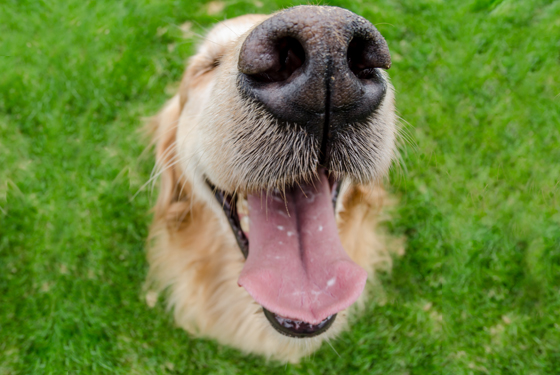The nose of a dog
A dog’s nose is a real high performance instrument. With its help, dogs are not only able to track down missing people, but can even detect illnesses such as cancer, a sugar shock or corona. However, in order to work optimally, a dog’s nose must not be too dry.
How does a dog’s nose work?
Dogs have a much stronger sense of smell than humans. There are several reasons for this. The first can be easily spotted by anyone who owns a dog. Take a close look at your pet’s nose. You can see not only its nostrils, but also small slits on the sides. Air enters the lungs through the nostrils and is expelled through the side slits. When the dog inhales, a complex process takes place: this begins with the air entering the lungs and supplying them with oxygen.
The dog is now also able to perceive odours. While humans have approximately 5 million olfactory receptors at their disposal, dogs have up to 300 million. And that is not all: dogs have a much higher respiratory rate. A sniffer dog breathes in and out 250 to 300 times per minute during an intensive search. And every breath delivers new information to the brain. Ten per cent of a dog’s brain activity is involved in the analysis, whereas for humans the value is much lower at one per cent. It is therefore no surprise that dogs have a sense of smell that is vastly superior to our own.
What is so special about a dog’s nose?
Not only the number of olfactory cells, the high breathing rate and the powerful capacity of the brain are responsible for the outstanding ability of a dog’s nose. Dogs are also able to smell stereoscopically. While we are only aware of the smell of pizza in our home, dogs can identify the exact direction from which the scent is coming. And they can do this long before we can even smell it. This is helped by the olfactory mucosa, which, depending on the breed of dog, covers an area of up to 200 square centimetres, while the figure for the human olfactory mucosa is a mere five square centimetres. However, due to the different shapes of their noses and muzzles and their size, not all dogs are able to smell equally well. A German shepherd, for example, has a much better sense of smell than a dachshund.
And as if the performance of the nose were not already high enough, dogs take things one step further when it comes to their sense of smell: they have what is known as the vomeronasal organ (VNO), or Jacobson’s organ. This is located behind the incisors, near the roof of the mouth. The roof of the mouth and the nose are connected via a small opening. This allows the dog to direct substances absorbed through the tongue to the olfactory cells. So basically, a dog can even “taste” a smell. And that is not all: the Jacobson’s organ also helps it to perceive tiny pheromones. In interaction with the nose, this helps to explain the extraordinary abilities of search dogs.
What can I do to help if my dog has a warm, dry nose?
The noses of our dogs are usually wet and cold. This is partly due to the fact that dogs regularly run their tongues over their noses, and partly because glands in the nasal cavities produce fluid. The reason for this is that the olfactory function works better in a moist environment.
The drier and warmer a dog’s nose is, the further its function decreases. Any owner of a search dog knows this, and they will give it water at regular intervals because the increased breathing rate can cause a dry nose. This is why you should always ensure that your dog receives enough fluids. If your dog has a dry nose as well as a high temperature, you should consult a vet without delay.

Can dogs sniff out corona?
Throughout the centuries, dogs have always been a great help to us with their highly effective noses. And this continues to be the case today in a variety of special situations, for example as drug detection dogs and search and rescue dogs. They are, however, capable of much more: dogs are able to smell illnesses and infections! Researchers have found that they can tell if a person has cancer with the help of blood samples. Some dogs have a success rate of over 90 per cent. They show equally good results when working as diabetic or seizure alert dogs.
It is therefore no surprise that research is also being carried out on the detection of the corona virus using specially trained dogs. Initial results show that after a few weeks of training they also have an excellent success rate in this field. As a result, sniffer dogs are already in use at airports in Dubai, Helsinki, Beirut and Miami. In Germany, the University of Veterinary Medicine Hanover has carried out successful tests on concertgoers, and their use in old people’s homes is also planned. This is another area in which their excellent skills will undoubtedly prove invaluable.
You may also like this

Dogs’ eyes
In the event of an eye condition, a vet should be consulted

When a dog has a dry nose
There are many reasons for a dry dog nose

Fever in dogs
What to do if your dog has a high temperature and feels poorly

Dental problems in dogs
Well-kept teeth protect against tartar and bad breath
